#(million dollar concept. I might use that actually…)
Explore tagged Tumblr posts
Text
Wildest thing supernatural ever pulled was the “two prophets can’t exist on earth at once” thing cause it results in a malformed prophet and..something something balance of the universe..something like that..I can’t remember. Like..what do you mean we can’t just have a cool prophet duo? We just deserved more prophets in general! They were so interesting and had layers to them,their whole entire concept was so cool to see and yet we saw so little of them in a sense. I just wish they were utilized a biiit more.
#y’all know what I mean..? do y’all see the vision?#dude when Kevin was introduced I was like ‘oooh what’s happening here?’ ‘OOOOH NO WAYYYYYYY. prophets?!’#you know what else we needed? a female prophet.#fun fact my supernatural oc was originally a prophet!#I scrapped that concept because of the rule that only one prophet can be active at a time came into play#stupid ruuule….#a prophet and another prophet coming together as a team?! you know how fast they could’ve gotten done with translating??#or a prophet gets activated too early and ends up meeting Kevin and Kevin eventually teaches them that it ain’t all so bad#that just because they got activated early doesn’t make them broken in any way. that it was just their time to step into the game#(million dollar concept. I might use that actually…)#we just deserved more prophets! give me more prophets!#screw that damn rule..I don’t liiike that ‘one prophet at a time’ rule#no! give me a prophet duo!#supernatural#spn#spn Meta#(I guess)#ari’s rambles#late night thoughts about spn#(Ignore that it’s the middle of the afternoon)#(the tag still counts)
13 notes
·
View notes
Text
what is going on with tumblr right now 😭 first we have people calling other people liars for showing off their success story without proof no offence but no one’s owes you proof, don’t be miserable and start attacking other people behind a screen demanding proof and calling them all sorts of names. you all need to get a good grip of yourselves and start thinking as a limitless fucking being and actually study LOA and the void. the void isn’t a genie either it’s just a state of consciousness where you are more connected to your subconscious mind?? but even then you can all manifest all of this shit fucking consciously too??? you don’t need the void for absolutely everything, it is not your saviour or a genie, it’s your subconscious mind who shifts realities for you to have your desire, we shift every second every day with every thought.
shifting realities is like shifting where everything is the same but you have your desire. you wanna manifest an SP? you just affirm and visualise and act like it’s already true but don’t go asking other people for their affirmations, majority of the time it’s in the post they post and there’s a reason most LOA coaches ban questions too cos some people ask the most ridiculous questions ever?? you can induce the void for desires sure but i am also meaning you don’t need it for everything you just need to step into your god power because the void is literally just a STATE of CONSCIOUSNESS it doesn’t grant your wishes your SUBCONSCIOUS does that because there is no limiting beliefs to interfere with it. but you have been manifesting your whole life, if you are assuming your life is shitty then you gotta change your assumption bb it’s about reprogramming your subconscious mind to get what you want, it’s doing self concept but also knowing it’s not the key to getting everything you want it just helps, you need to look at what limiting beliefs you might already have and you will need to affirm against you could be trying to manifest an SP but have some dominant belief from when ur sad ur gonna be alone for the rest of your life, it’s those type of limiting beliefs u gotta get rid of if u wanna successfully manifest an SP.
it’s those type of things you need to look at if ur wondering why ur manifestation is taking so long? it’s stepping into your god power and keeping yourself in the knowing state it’s yours or knowing it’s gonna happen. manifestation has no limit to anything, why do you think we say everything is possible? there are INFINITE realities, that’s why we always shift to one where we have our desire once we stop fucking complaining and acknowledging the shitty life you used to have, why do you think almost everyone tells you to ignore circumstances? 3p who? that job still hasn’t hired you? no girl they’re DEFO hiring you! you don’t like that person? just literally shift to a reality where they never existed?!!! manifestation has no fucking logic whatsoever your subconscious literally does not know the difference between logic or not it hears what you are constantly affirming and produces it into ur reality, people have fucking revised deaths, yes literal deaths, and no it’s not bringing people back from the fucking dead it’s shifting to a reality where they never DIED, so when we tell you to throw that logic bitch out the window, we mean it! if you cannot expand your mind past logic, then that’s on you girl.
you need to go study LOA or better yet try manifesting something that seems to illogical or impossible and if you are able to manifest it and shock yourself just like us, maybe then you’ll stop attacking people on the internet. when you manifest, you shift, shifting is manifestation.
you shift to a reality where you have your desire, if someone shifts to a reality where they make a million dollars a month that’s literally their reality to which they don’t need to prove because like we have said a million fucking times manifestation has no logic. your subconscious does not know the difference. why do you think people have revised deaths? because the subconscious 👏🏻does👏🏻not👏🏻know👏🏻the👏🏻difference👏🏻
it is very simple to understand, if you can’t understand the infinite possible amount of desires to manifest then you’re gonna stay in a box your whole life and that will be your own problem. yes it is possible to shift to a reality where you make a million dollars a month, yes it’s possible to shift to a reality where animals can talk, yes yes yes yes it is fucking possible.
so why are we all calling people liars? have you even tried manifesting what they were able to? or you just jealous and miserable cos you haven’t induced the void yet yourself? or because it just seems impossible to you because you decided to put yourself in a box for no reason. maybe if you think it’s impossible why don’t you put yourself to the test, if they were able to, why can’t you? and when you finally have your own success story how are you going to feel when you have dumb limited people in your comments dragging and calling you a liar and demanding proof? like how are you going to feel? are you gonna feel the need to HAVE to prove yourself like every other creator posting their success or are you gonna think why are they putting themselves in a box when they could have all their desires too if they wanted?
it’s the same for people calling US selfish for not helping them induce the void? or even more so manifesting they get in? lemme make it clear, no one can manifest you getting into the void, you are the creator of your own reality no one can manifest anything for you in your own reality it’s impossible. your subconscious acts on YOUR thoughts no one fucking else’s. that is the only impossible thing when it comes to manifestation. secondly there is plenty of info on here on how to induce it, there is success stories of people even describing what they did. the info is the help you need and have, there is plenty of methods on here but even then you don’t need method you just need to find what works for you, anything to help you relax and forget about the 3d. so calling people selfish when they have literally produced info on how to induce it just cos they are not manifesting for you to get in which like i said is impossible. because your sub cannot work on others thoughts but your own, yes you can shift realities but you shift realities from YOUR thoughts no one else’s. you have to find what works for you. but yes anyway, calling people is selfish is just rude, no one is obligated to help you so why the he’ll are you demanding it? like seriously what is going on with yall. if ur acting like this instead of doing the work yourself and thinking as a limitless being with no logic to anything they desire then you need to take a good look at yourself, you could have the dream life you wanted if you actually did the work for it just like we all did and have, we have all had shitty circumstances but we all still did whatever we had to do to manifest what we wanted.
STOP THINKING INSIDE THE BOX AND START THINKING OUTSIDE THE BOX AND STOP BEING SO RUDE AND ENTITLED TOO, YOU ARE NOT OWED ANYTHING. IF YOU THINK MANIFESTATION IS A LIE THEN JUST GET THE FUCK OUT OF HERE AND GO KEEP LIVING A MISERABLE LIFE.
#dont piss us off #stop being so entitled #focus on manifesting your dream life or get out of here with your limiting beliefs
#law of assumption#void state#loa#reality shifting#neville goddard#sammy ingram#pure consciousness#void
43 notes
·
View notes
Text
Padme, during RotS development
One thing to understand is that for the first several months of pre-production, George Lucas is still writing the script (pre-production started roughly around late April of 2002, with the first draft of the script finished in late January 2003. To quote Paul Duncan: 'before the script was written, the design team were given the freedom to imagine possible scenarios', and Rick McCallum: 'usually no one would go off and spend millions of dollars without understanding what the very foundation of the film they're making is, but we break that very rule of film production'.
Sources for this post are The Art of Revenge of the Sith by J. W. Rinzler (2005), The Making of Revenge of the Sith by J. W. Rinzler (2005) and The Star Wars Archives, 1999-2005 by Paul Duncan (2020).
It's also going to be a long ass post, so see under the cut.
June 7-21 2002(?): Ryan Church painted a battle scene: 'What if a bunch of bad guys were attacking Padme and the clones who were trying to get back to their ship?'

August 2002: While revieving costume designs, GLucas indicated that Padme will need senatorial, casual and action wear.
October 12th, 2002: 'For the first time, it is rumoured that Padmé might die in this film. She might be seen last on Alderaan.'
October 25th-31st, 2002: In response to GLucas requesting a new locale for a Padme and Anakin 'love scene', Erik Tiemens designed several Naboo sceneries. Upon viewing them, GLucas moved the scene to Coruscant; some design elements are used for Kashyyyk.
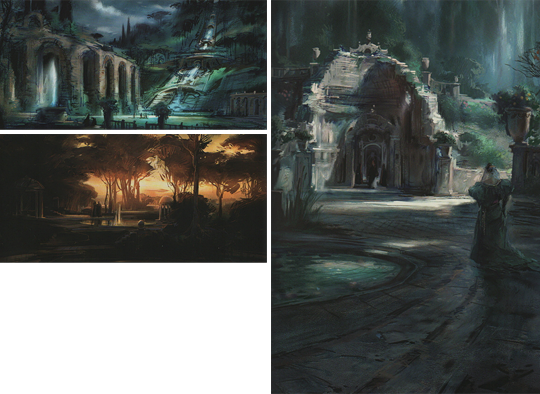
October, 2002: Iain McCaig designed costumes for Padme. Note the bird of prey.

October 2002: While designing the world of Kashyyyk, Erik Tiemens painted a scene of Padme walking with wookies. (Note: Image is a cropped version of the full art work)

November 1st-8th, 2002: Iain McCaig: 'George said there might be a scene where Padme's doubled over in agony and Yoda is there unable to help her'.

November 22nd, 2022: Erik Tiemens designed a set of new locations for Padme and Anakin 'love scene' on Coruscant.
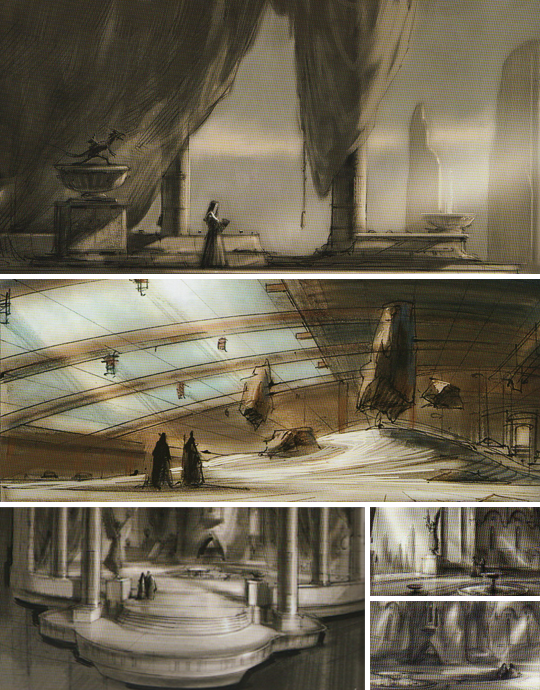

December 19th, 2002: Erik Tiemens: 'I was brainstorming with Iain [McCaig] and he thought that Padme might have a dagger in her hand'.

December 20th, 2002: Derek Thompson illustrated his idea of having Vader find Padme and the children, who are being protected by Jedi.
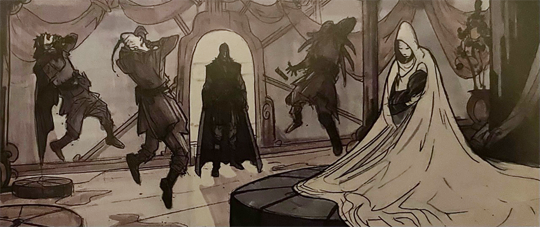
January 31st 2003: GLucas delivered the first rough draft to his producer Rick McCallum. The outline given in the book is brief, but Padme's basic storyline in the 55 page script appears no different. However, Anakin's nightmare about Padme features her consumed by flames, and Padme goes to Mustafar with her handmaidens and Captain Typho - who are gunned down by clones on arrival.
February 6th, 2003: Erik Tiemens designed a piece of concept art for Padme's funeral procession.

April 12th/13th 2003: GLucas presented the first official draft of the movie script. It's 111 pages long. Padmé and her entourage are still attacked on their arrival on Mustafar, but this time by droids whom Anakin defeats. In regards to Padme's death, Palpatine tells Vader that a Jedi murdered her.
May 5th, 2003: Iain McCaig's designed Padme's funeral outfit.

May 24th, 2003: Erik Tiemens illustrated Padme and Anakin's farewell before he leaves for Mustafar.

May 29th, 2003: Erik Tiemens illustrated Padme watching the Jedi temple burn.
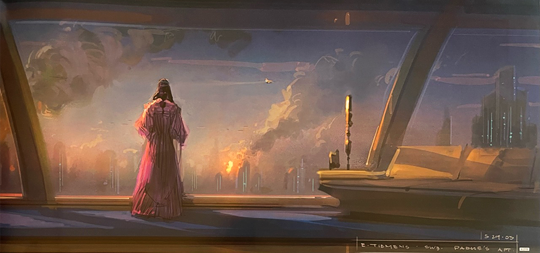
June 13th 2003: GLucas presented the second official draft of the movie script. It's 135 pages long. Anakin's nightmare of Padmé is changed from her being consumed by flames, to her dying in childbirth. There is now a scene where Palpatine suggests to Anakin that Obi-Wan is meeting with Padmé secretly. In regards to Padme's actual death, Palpatine tells Vader that he [Vader] murdered her, just as in the movie. Just like the finished movie, it is noted that Padme dies of a broken heart. Padme's final smile at Leia is noted to be the smile that Leia remembers in RotJ.
June 26th, 2003: The fourth draft of the script is completed, consisting of 129 pages. Padme is no longer accompanied to Mustafar by Typho and her handmaidens.
June 30th, 2003: Principal photography begins.
July 2nd, 2003: First Padme scenes are shot, both located in her apartment (Her and Obi-Wan discussing Anakin, and Padme with the other senators).
July 3rd, 2003: Revised script for the scene in which Obi-Wan tells Padme he knows about her and Anakin.

August 12th, 2003: Last day of principal shooting for Natalie Portman.
September 17th, 2003: Principal shooting finishes.
December 21st, 2003: Iain McCaig designed a practical costume for Padme.

March 9th, 2004: All but the last ('thunderous applause') of Padme's political scenes have now been cut from the final film.
August 23rd - September 3rd 2004: Reshoots
August 23rd, 2004: Additional scene scripted for reshoot the following day.

January 31st, 2005: One last day of filming for Natalie Portman and Hayden Christensen.
Script excerpt (unknown date)
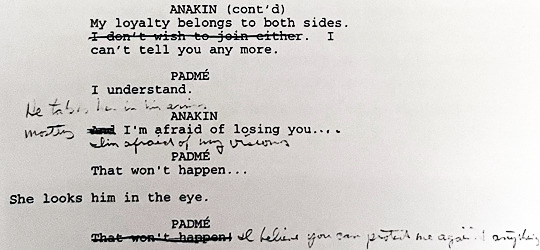
Art (unsure dates)


Padme's apartment layout and colours

84 notes
·
View notes
Text

Creating in Spite of Self-Doubt
It’s the saboteur within and it can torpedo our dreams.
“The worst enemy to creativity is self-doubt.” ― Sylvia Plath, The Unabridged Journals of Sylvia Plath
Every writer I know, including myself, has anxiety and self-doubt about their creative efforts. When I went into it further, I found that it’s the curse of the creative classes.
The Gifts of Creative People
Creative people see possibilities, value complexity and have the gift of innovation. They can bend their glorious imaginations to envisioning new things or ideas. Often sitting a little (or a lot) outside of the mainstream, they have a different lens through which they experience the world. At their best, creatives see possibility everywhere and enjoy experimenting with concepts and perspectives. What they love most is bringing those ideas into form, whether it’s a book, a painting, a poem or an entrepreneurial venture.
The downside? The gift of a rich and profuse imagination holds within it a curse.
Every Creative Person Has Self-Doubt
It takes a big imagination to come up with all the reasons why our work isn’t good enough and why it shouldn’t be released into the world. Some common themes run through all self-doubt scenarios:
1. Confusing the value of our contribution and our infinite self-worth as a person.
Overidentifying with how an idea or creation might be received can cause us to supress the creation for fear of judgement, criticism or ridicule.
2. Interpreting any feedback as criticism.
To avoid any possible negative feedback, we get to the final stage of bringing something to life and then hide or quit.
3. We feel defeated when our creations don’t match our visions.
No matter how bright and sparkly our ideas are as they frolic in our brains, bringing them into form irrevocably changes them. It’s easy to feel frustrated and deflated when our creations don’t fulfill our visions.
4. Comparing ourselves to others
It’s oh-so-easy to slide into idealizing the lives of others doing what we want to do and tip over into comparison, envy and resentment. Feeling like a loser is very common. At times we feel like our noses are pressed up against the window with the desired object forever out of reach.
Sneaky Ways Self-Doubt Sabotages Us.
1. We find safety in the possibility of creating without actually delivering.
It’s known as Shiny Object Syndrome. We feel overwhelmed with ideas; find it impossible to choose, bouncing from project to project never completing anything. This leads to invidious comparisons with our original vision and the output of others.
2. We juggle too many projects at once.
In the vain attempt to act on multiple ideas at once, we fail to align our projects with our desired outcomes. We dissipate our energy across too many projects. The result is we wear ourselves out before anything is completed. Therefore, we save ourselves from having to release anything out into the cruel world. You are likely to feel depleted when there isn’t a clear alignment to what you really want. Honouring the ebb and flow of our personal energy is a big deal for creatives.
3. Our Inner Critic runs amok.
This is the helpful little voice we hear that tells us nothing we produce is good enough. This voice is a complete jerk.
It is scornful. “Who are you to thrust such paltry ideas on an unsuspecting public?”
It mentions (often) our terrible limitations, our hopeless inadequacy, the impossibility of ever getting it right. If we let it, it can bring us to our knees.
4. Falling for the carrot on the stick.
We find ourselves saying things like, “If I ever get ______, then I’ll____________. E.g. “If I ever get published, then I’ll call myself a writer.” “If my painting is accepted by this gallery, then I’ll call myself a painter.” “If my business hits a million dollars in sales, then I’ll feel I’ve made it.”
“But until that day, you’d jolly well better not call yourself a _______,” says the Inner Critic.
The Bad News
Self-doubt never goes away. It rises and recedes and sometimes lies dormant for blissful periods of time. But it always comes back! Nothing we ever gain or accomplish will erase that doubt entirely. It goes back to the same brain that can imagine wonderful creations can also imagine why they can and have gone wrong.
But when self-doubt has our confidence swirling down the drain, we can be prepared.
Defences Against Self-Doubt
Sas Petherick, Self-doubt Researcher + Coach + Podcaster suggests, “Go on a comparison diet and remove any people or apps that become your default shadow comfort when you get stuck.” She also offers the following practices:
Start a 30-day project and do something easy and creative each day, just for fun.
Begin a conversation with your inner-creator - the part of you that leads from curiosity, innovation and inspiration. What does your creator-self want for you?
Explore the question, “What does being ‘creatively courageous’ mean to you? In what ways do you wish you were more courageous?”
To her sage advice, I would add:
Accept you’re going to have self-doubt.
You’re never going to get rid of it completely. That doesn’t make you damaged or peculiar or deficient. You have self-doubt because you a creative person.
Accept the self-doubt and decide to create it anyway. Don’t listen to the doubt that tells you to quit.
Accept that not everyone is going to love your work
Criticism is just someone else’s opinion. Even people who are experts in their fields are sometimes wrong. It is up to you to choose whether to believe some of it, none of it, or all of it. Their criticism (or what you interpret as criticism) is only about the creative output. It has nothing to do with your worth as a person.
The hard truth is that we never really know what someone else is thinking nor can we control it. It’s what you think that counts.
Give yourself permission ‘fail forward’.
Yes, this means what you create may be “all wrong.” Learn from it.
If you keep going, you will improve—even when creating crap. Tell yourself, “It’s okay if I suck right now. I will figure it out and it will get better.”
Stand up to your Inner Critic.
You don’t need to pay attention to the insidious voice within you that creates pain, or makes you feel less competent, smart or able.
Just because the Critic tells you something that does not make it true.
Look for three things that make what the Critic is saying false. Give your Critic a name. This immediately distances the Critic from “me”. So, for example, my Inner Critic is called Delilah. This helps me to see her pronouncements as an external point of view and not as true statements.
Write Your Manifesto
This is a declaration of your promise to honour your creativity and to engage in it no matter what. Make a fancy poster, print it off and stick it up where you can see it while you work
It might look something like this:
· I will _______ when I don’t feel like it.
· I will _______ when it hurts.
· I believe I can ________, even if I don’t always get it right.
· People want to ______ what I create. I know because I want to _________ it, too.
· It’s okay if I fail right now. I will figure it out and get better.
· I will not stop _________.
If you hang on to these four steps, you’ll make it through.
Believe in your ability to create.
Believe that being a creator is worth the fight.
Know the episode of doubt will pass, and it will also return. Doesn’t mean you have to let it win.
Do NOT listen to the doubt and stop creating. Creating garbage is far, far better than not creating at all; bad practice is better than no practice.
REMEMBER: When we try we might fail, when we succumb to self-doubt, we doom ourselves to failure.
#writing#amwriting#writers#writers on tumblr#writerscommunity#writers and poets#creative inspiration#creative writing#creativity#writing inspiration#inspiration
19 notes
·
View notes
Text
Understanding Class Solidarity

Prewriting this and putting it in a queue. Is Hollywood still striking?
Well, does not matter. Because I gotta talk about another important thing when it comes to leftist thought. Another thing that the capitalist system has kinda managed to very successfully distort. The concept of class solidarity.
See, no matter whether SAG AFTRA and WGA are still on strike when this is going up, the entire issue has shown this - though of course it also has kinda helped some more people to understand this, too.
Because the first reaction of many people upon those folks going on strike, was: "What are they complaining about? They are Hollywood! Hollywood is where the money is!" This was especially true for when the actors went on strike, because we kinda associate actors with being rich. Because we usually think of the likes of a Chris Hemthworth or a Scarlet Johanson, who get like millions per movie where they show up. But people obviously forget that most actors are in fact some random background faces, who barely scrape by. The big actors going on strike, too, is in fact a form of class solidarity.
See, capitalism has told us that the classes are like the middle class, the upper class and the lower classes. And, sure, yeah, those are kinda classes as well - and classism is very much based on this. On the economic standing of people and the marginalization of poor people is very much real.
BUUUUUUUT...
You know what the entire marxist theory says about the classes?
Yeah, there are only two. There is the owning class and there is the working class. And it turns out, that even quite a few of those multimillion dollar actors are in fact still working class, as they do not own the companies in which they make their money. And yes, note, some do. There are a couple of big wing actors who do in fact own the production studios they work under. But this is not true for all or even for most.
And here is the thing: The difference between the owning class and the working class is, that the working class works and actually produces value, while the owning class profits off that generated value.
That is also why the saying goes: "Every profit is stolen wages." And this is true, no matter whether the worker makes 25k a year, 100k, 500k or 3m. If they are the worker, they are almost by necessity exploited. Just that some get exploited a ton more.
To keep it with the film studios, because it is a nice example to have.
Who really made it possible for like Avengers Endgame to bring in 2 billion bucks. Was it Bob Iger (or Bob Chapek)? Or was it like the directors, actors, costume makers, set makers, camera people, technicians, CGI creators and what not? Who really did generate that value?
And understanding that is the core to understanding class solidarity.
The system right now is very interested in people not realizing it. That we actually all do have more in common with other workers, than we have with the owning class. That if we just all went on strike, that the owning class would loose everything.
The average person with their 40k/year office job does have more in common both with the B-List actor, who might make a couple hundred thousand per movie, AND with the black trans 20 something homeless kid working at Starbucks while living on their frined's sofa.
Because all three of them do not own the fruits of their labor. All three of them have their life dictated by people who own whatever they are working for.
Class solidarity is to understand this and to stand side by side with everyone who is striking and fighting for their right to get treated fairly.
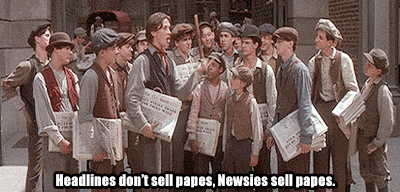
#anarchism#communism#anti capitalism#class solidarity#strike#striking#unionize#labor rights#labor unions#working class#eat the rich
51 notes
·
View notes
Text
Mount Rageon Headcanons
I've been having a rough week, so Mount Rageons have been on my mind. I'm not well versed in science, but I've been thinking of a few concepts about them. Bare with me and click the "read more" button to read it all because this thing is pretty long!
First of all, I'm not sure what kind of animal species they would be. Like, is that just me wondering that? While they're humanoid, I thought it was interesting how their hair and skin were rendered. Their hair doesn't seem to be how hair would be on regular animals, where each strand is enormous and has a similar texture to their skin. I'm wondering if what we're describing as hair, isn't actually hair? Also, their proportions and body structures are interesting. The large head-to-body ratio and the flexibility of their limbs remind me of reptiles or marine life. Like, I feel that a species with a large head, skinny body, and hyper-mobile limbs would have a problem staying upright, especially at a high elevation with all that gravity acting on them.
While we haven't seen any adults, I thought it was really interesting how they're completely physically genderless but have gender aesthetics. On another contradictory note, wouldn't a developmental stage compared to a teenager (especially considering we see a wide range of teenage characters) at least look somewhat close to how an adult would look? If you look at the Mount Rageon characters, you'll notice that they're all universally built the same and even the eyelashes aren't universal in female characters. I'm actually wondering if that's supposed to be a gender indicator at all or if it's a cosmetic choice. I want to believe that they're completely indistinguishable gender-wise and choose what they want because I think that would just be really neat!
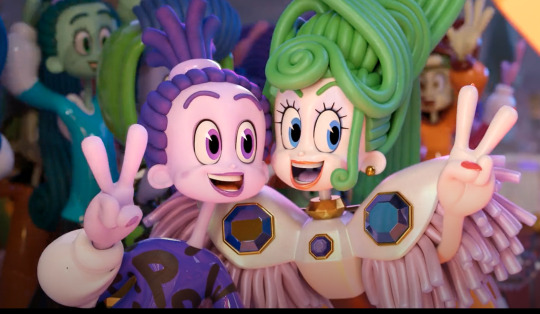
While nothing is supporting it in canon, I believe that Mount Rageons may not be native to the region we see in the show. The extreme color variance stood out to me because the official map shown outside of the movie indicates that the plant life in Mount Rageous is either non-existent or dead. Wouldn't the coloring imply the environment they lived in, like how animals in the real world are? The ground in this region is colored with a pink-gray hue, which looks like an intentional choice given that other regions have specific variant colors used. While I may not be ruling out that Mount Rageous may have once had lush plant life and the environment was polluted too much, it's at least established that the phrase "Mount Rageons" specifically refers to the teenage population that has moved up to the higher elevation of the mountain. I personally would like to refer to other age groups in their species as "Rageons" for this reason. They also aren't built like they naturally would survive in a mountainous region. Mount Rageons have very spindly limbs and they all lack body fat. I think that they may compensate for their lack of natural body heat through their thick jumpsuits. While it may be a wacky fashion, it also may be practical as well.

On the subject of body types and Mount Rageons, I'm also thinking about the flashback scene with Velvet and Veneer. Perhaps they eat fat and sugar in larger amounts as part of their regular diet because of a really high metabolism. It might explain why the foods in that scene are so strange looking. If I were to combine the previous idea with this current on here, maybe they're expending large amounts of energy by not being fit to be living on a mountain and are burning calories quickly. If I'm going to pretend that the scenes exist on their own and are not made by people who might default to thin body shapes, it might also explain why we don't see any plus-sized Mount Rageons in the cast.
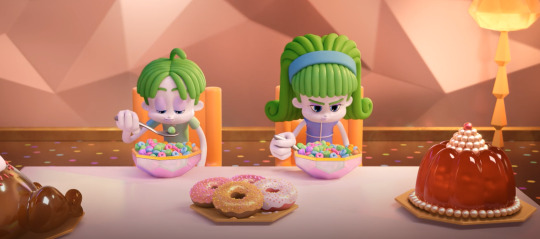
Here's the million-dollar question: Why are teenagers separated from their parents and made independent so early? While it may be easier to say it's just cultural, I like to think that the large amount of people who live in Mount Rageous combined with how desolate the environment is means that it may also be for survival. When children reach the age where they're not as easy to watch carefully and are more likely to sneak off to potentially get themselves killed, they may be sent off to Mount Rageous because it is safer. Their parents may be giving them money to live on their own until they can grow up to face whatever the hell is towards the bottom of the mountain. To shorten what I'm saying, it's both cultural and for safety. I'm not sure if there will ever be a confirmed reason, but it sure is fun to speculate!
Thanks for reading if you got to this point!
42 notes
·
View notes
Text
US Elections - A Few More Thoughts
There's something YouTube Atheists taught me, over the years. For one, they've taught me that even someone who's objectively correct can be a raging cornhole who you would very much like to Shut Up, and secondly that education can lead to a strangely contradictory reaction in the face of things like Trump's re-emergence.
That would be the Fallacy of Incredulity; or the underlying thesis that as I, as someone who is educated, worldly, self-aware, cognizant of the world stage and focused on both my personal betterment and that of others, have the utter and profound disbelief that others might vote vore or otherwise perform actions that are detrimental to themselves.
In simpler terms, that gives you the billion comments across thousands of platforms, that typically go something like "I can't believe fifty million or more people could've voted for this guy!" or "I can't believe we've done this!" or, even more naively still, "This isn't us!"
First, that shows you that even the most Humanist, dyed-in-the-wool Blue voter with a noted track record of Atheism still has faith in something - namely in the idea that the people around him remember what E Pluribus, Unum actually means. It also shows you that the same person has rose-tinted glasses firmly stapled on.
You have to consider the fact that as of the eighties, the Democratic Party has become the party of the intellectual elite, of coastal company leads with feet firmly entrenched in the Tech and Political spheres. It's the domain of those who at least understand the threat posed by Global Warming, and of those who see how the Western world's commitment to Democracy has been waning, as of the past two decades. It's the party of Centrist Sensibilities, that tries to steer the country towards a more rational future while still trying to pat down concepts like American Exceptionalism or even the Dominionist school of thought stating that hey, even if we're trying real, real, real hard to be secular, y'still gotta leave some space for my man Evangelical Jesus, y'know?
As to why it does that last part, it's easy to understand. Either you placate the Rust Belt and the Southern States led by would-be theocrats by assuring them that nonononono, the whole concept of Creflo Dollar Megachurches is totes fine, or you lose the manpower. Which is ironic in and of itself, as most of these States now rely either on unpaid labor from inmates stuck in revolving-door work-release programs for those in the prison system, or on dubiously-documented immigrants.
So let's tackle the root of the problem, then. Why Trump? Because Democrats have forgotten how to speak to people that live from paycheck to paycheck, if they only do so much. If you're stuck down South in a food desert and the cost of a dozen eggs becomes a serious concern for you, you're absolutely not in the right headspace to discuss things like the climate crisis or LGBTQA+ rights. No, these people aren't ignorant rubes - just ask Jonathan Maslow.
People voted for Trump because their needs are not being met. They've voted for a fallacious response, sure, as the Republicans are the party of partisan Big Tech and corporations playing buddy-buddy for tax incentives and most assuredly not the Party of the Average Joe.
So. In the coming days, try and stop demonizing those Trump voters in your vicinity who aren't MAGAts fully lost to the idiot's rhetoric. Most of them latched onto the idea of lessened tarrifs, of slashed taxes, and voted primarily to feel less of a pinch in the wallet at dinnertime. Most of them aren't bigots; they're just scared and fail to see their other options. It also means that Dems have an exam of conscience to go through, as they can't simply coast on being the Party for the Guys Who Fit the Bare Minimum of Being Mentally Stable. There's a dearth of education to fix that is crucial to reversing your fate, as most Republican voters do not, in fact, have so much as a Community College degree.
If the elections' results mean one thing, it's that half of America's citizens are scared, kept wilfully ignorant and afraid - and these aren't those who voted Democrat.
4 notes
·
View notes
Text
youtube
Andrew Doyle asks: Remember when the pride flag made sense?
Remember when the pride flag made sense?
It was designed by an American Artist called Gilbert Baker in 1978. It was originally an eight-stripe rainbow but was soon refined into the six-striped version that was the norm for many decades.

At a time when gay people couldn't hold hands with their partners on the street, this flag served a useful purpose. It meant that you could easily find gay pubs or other places where no one had to pretend to be something they weren't. The rainbow symbol was a simple and effective concept that conveyed positivity and unity.
And then some activists came along and said hang on a minute, why are there no black or brown stripes in the rainbow flag? See, for some reason they were under the impression that the gay flag was a literal representation of the range of skin colors that are acceptable in the community. And so we got this.

Okay then, I mean, well, there weren't any white stripes in the original one either. But most people understood that it was symbolic with that we were all included already, irrespective of our race.
But then after this, trans activists came along and said, why aren't we in there? So we got this one. And this was the chevron with the pink white and blue, which was based on the trans flag.

But surely this eyesore couldn't get any worse, could it? Well, it could, because activists were then concerned that it was excluding intersex people, so they added this symbol.

Okay, it's getting a bit out of control now. But then last year, some bright spark added a red umbrella to represent sex workers.

Now, if you thought this was getting out of hand, last year then we had Microsoft. They designed a new version to incorporate all the other multiple sexualities and genders that have been invented over the past few years. Let's have a look at that.
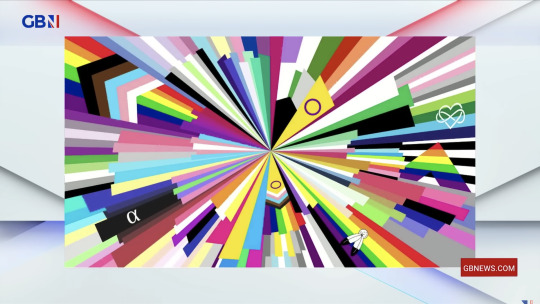
I mean, what the hell is it? It looks like a space ship going at warp speed through a Care Bear's bum hole.
Identity politics in its current form is an ever expanding beast. Pride used to be just one day. Then it was a month. And now Pride events have been scheduled all the way from March through to September. As one sign in a shoe shop pointed out Pride never stops. If only it would.

The initialism as well that's expanded too. First we had LGB, and then it became LGBT, then LGBTQ, then LGBTQIA. The Canadian government currently favors 2SLGBTQIA+, although even its prime minister finds that a bit of a mouthful.
Similarly, Pride started out as an important protest against injustice. When the original Pride March took place in London in 1972, homosexuality had only been legal for five years, and the prospect of gay marriage or even an equal age of consent, seemed impossible. Only 2000 people turned up to these protests.
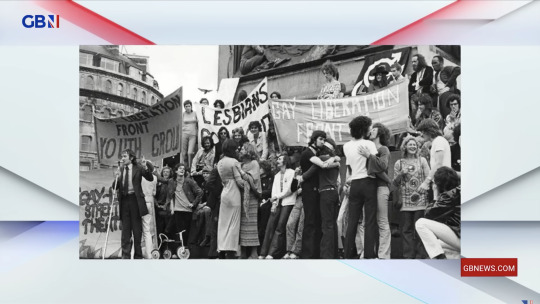
But by contrast, the Pride parade in London in 2022 attracted over a million. And of course, most of those people aren't even gay. It's become a family day out, a huge party.
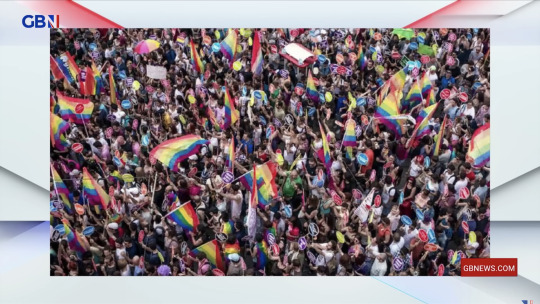
And what's so wrong with that, you might ask. And that's a fair question. If people are celebrating and having a good time, that's great. Except that's not necessarily what's going. Increasingly, gay people no longer feel welcome at Pride. I spoke to a representative from a lesbian group on this show last year who had been moved along by police when trying to protest at Pride. But isn't Pride meant to be a protest, not a party? What's going on?
The answer is that pride has been hijacked not once but twice.
First by avaricious multi-billion dollar corporations who are able to pose as virtuous by posting the pride flag. Only, they don't do it in the branches in countries where homosexuality is still illegal. After all, you wouldn't want to fly the flag anywhere which might actually make a difference.

I'm old enough to remember that corporations were certainly not celebrating Pride quite so openly before section 28 was repealed in 2003, or before the age of consent was equalized in 2001, or before the decriminalization of homosexuality in Scotland in 1980. So, these corporations' commitment to LGBT rights apparently only manifests itself when it's likely to make them a profit.
And then there's the second hijacking. See, whereas the original Pride was about agitating for equal rights for gay people, it's now been taken over by activists who are obsessed with group identity and who believe that gender is more important than sex.
That's why the British library, to celebrate the advent of pride month this week, posted a thread on Twitter about the sex life of fish, and how some species have been known to change from male to female.
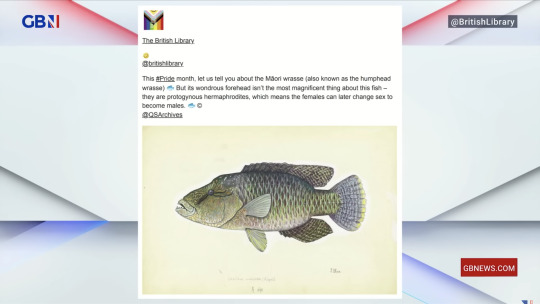
I mean, what's that got to do with Pride? Why have Librarians seemingly forgotten that human beings aren't the same as fish? Now, they've since deleted those tweets, because well, you know they're bonkers. And although we might laugh at that kind of nonsense, the ideology it promotes is actually rather sinister, particularly for gay people.
See, in her book, "Time to Think" by Hannah Barnes, she found that between 80 and 90% of adolescents referred to the Tavistock pediatric gender clinic were same-sex attracted. Studies have long confirmed a correlation between gender non-conformity in youth, and homosexuality in later life. At the Tavistock, staff used to joke that "soon there would be no gay people left." Somehow the medicalization and sterilization of gay people has been reframed as progressive.
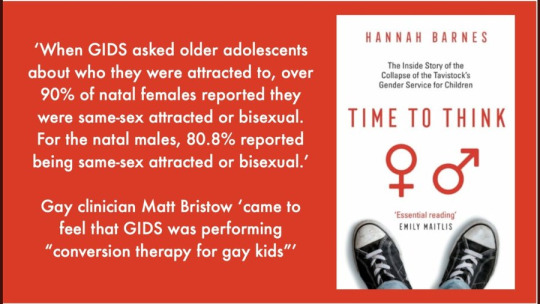
Even Stonewall, the UK's foremost LGBT charity has redefined the word "homosexual" on its website and promotional materials to mean "same gender attracted." Its CEO, Nancy Kelly, has claimed that women who exclude trans people from their dating pool are akin to sexual racists. There's been an intense resurgence of old homophobic tropes online from gender ideologues that believe that "genital preferences are transphobic" and that lesbians who don't include men in their dating pool must be suffering from trauma.
Gay rights were secured by recognizing that a minority of people are instinctively attracted to members of their own sex. And the new ideology of gender identity rejects this notion entirely, and actively shames gay people for their orientation.
So, when you see this flag, try to understand that many gay people consider it to be a symbol of opposition to gay rights, Women who are concerned about their rights consider it a symbol of misogyny, because it promotes an ideology that denies the reality of sex-based oppression, and yet most people, gay people included, haven't even noticed this transition from the pro-gay rainbow flag to this anti-gay imposter.
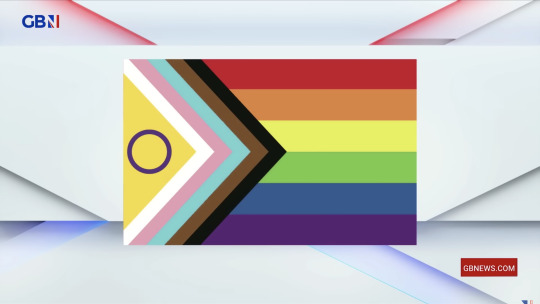
And that's because it all happened so quickly, and activists are playing on good intentions of a public who don't want to be seen to be on the wrong side of history. Well, I would suggest that upholding the rights of women and gay people and protecting gender non-conforming children and opposing the hypocrisy of corporations is the truly progressive approach.
Anyone who spends any time on social media would have seen that homophobia is clearly on the rise. It's coming from the reactionary elements of the right, who are now holding gay people responsible for sexualized drag shows for children, and the proliferation of sexually explicit books in school libraries. But of course, they've fallen for the trick. This isn't gay people. That's gender ideologues who've convinced everyone that the LGBTQIA+ movement is one big happy family, when it isn't.
And we know this because homophobia is also on the rise among gender ideologues themselves, who frequently go online to tell gay people to kill themselves. Some of them have said that they celebrate AIDS as a good thing. And this isn't just a few mad activists, there are thousands of examples of this if you've got the stomach to look them up.
So whether it's coming from those who consider themselves right wing or left-wing, anti-gay sentiments are back in fashion. And the best way to combat this is to remind everyone that that Progress Pride flag, and the corporate orgy that accompanies it, is not in the interests of gay people.
And if it's too late to reclaim the original Pride flag, we can at least ditch the new one.

#Andrew Doyle#Pride month#pride flag#rainbow flag#progress pride flag#ideological takeover#impostor#anti gay#homophobia 2.0#woke homophobia#gender ideology#queer theory#same sex attraction#gay rights#religion is a mental illness
67 notes
·
View notes
Text
Lost in Translation (2003)

"Couple of things. Taking a break from my wife, forgetting my son's birthday. And, uh, getting paid two million dollars to endorse a whiskey when I could be doing a play somewhere. But the good news is, the whiskey works.”
Quick, name the most hipster country!
The Netherlands, I heard someone say in the back row. For the bike infrastructure and urbanism. Very true, very good. Anyone else? The United States, a multifold country full of division no doubt, but also home to the very cities that originated the hipster. Quite fair. Denmark? Inventors of hygge? France, especially Paris? Why not.
There was a time we might have said Japan, and that time was 2003.
Here’s my theory. After WWII, both “The West” (a nebulous concept at best) and Japan both had to rebuild. North America chose economic force, industrialization, conformity, nose-to-the-grindstone work ethic, suburbanism, the detached house, the car, the white picket fence. Japan chose economic force, conformity, nose-to-the-grindstone work ethic, urbanism, the apartment, the high-speed train, the neon sign. In other words, enough similarity to work together economically while also dangling enough of a hook of alternative placemaking to temptingly make it look like an alternative to the mainstream. I think that might be why Murakami became popular with hipsters. I’ve talked about Murakami way back at the start of Project Hipster, before I was adding playlists and holding myself to a thousand-word minimum, and I will write about him again, in time. Over the 21st century so far I think the knowledge of Japan’s pretty oppressively conformist work culture has spread and killed that fetishistic fascination a bit. I mean, Japan’s still cool, I’d love to visit, but there’s definitely less of a “we ought to follow these Exotic Foreign Ways” than there was when we still called anime “Japanimation,” and when Sophia Copolla could make a movie just about sad white people hanging out in Tokyo.
Okay, so that’s reductive. And so was everything I wrote about America and Japan up there. Because if anticapitalist hipsters were fetishing Japan, at the same time, the Reaganite yuppies of America in the late century were chasing the economic powerhouse of Japan, and obviously hipsters ought to be against that. Can two dichotomies exist in an opposing dichotomy? What is that, a tetrachotomy? Or I guess it’s just the contradictory complexity of reality.
Case in point: Lost in Translation starts with a long, long shot of Scarlett Johansson’s butt. At first analysis we’d think, “ah, the males are gazing.” But of course the director is a woman, Sofia Coppola, of that first family of film that gave the world Megalopolis. Is she just trying to ape her male contemporaries? Or is this irony of the school of making the viewer look too long at what they think they want, making it painfully awkward and forcing us to question it? I can accept that. Johansson’s character is, throughout the movie, trying to break out of a sort of trophy-wife passive role. It’s a very passive movie in general, though, in a Japanese sort of way, so the breakout is subtle.
After the butt, as the shoegazey driving sound of Death in Vegas’s “Girls” comes in, we’re introduced to Bill Murray’s already sort of haggard face against a taxi window, playing Bob Harris, though at first he’s just eyes gazing wearily but in awe at the neon bombast of a Tokyo street. We mostly follow Bob for a while, a washed-out American movie star shooting whisky commercials abroad. Here we feel the gaze of the camera again, with uncomfortably– or perhaps comically– long scenes of Murray having to pose with a whisky glass according to convoluted but largely unclear instructions, the nuance of direction lost in transl… hey, that’s the name of the movie! His wife is practically estranged back home, faxing (faxing!) him for his opinions on ikea shelves. He wanders the hotel, looking out over the city lights, in slow, methodical moments. It’s all very Murakami again, down to the whisky and the enigmatic red-haired woman crooning “Scarborough Fair” in the rooftop bar. A lot of the miscommunication is funny, but more in a solemnly wry sort of way. The first time I watched Lost in Translation, Netflix listed it as a comedy, and I don’t think that’s quite right. But it’s not quite wrong. Murray does have his trademark moments of physical comedy, like getting stuck on an elliptical, but Ghostbusters this is not. Even that elliptical moment occurs in a wide and lingering shot of Bob exercising alone in front of windows looking out over the city, and there’s a touch of tragicomedy to it.
Meanwhile, fellow sad white wayfarer Charlotte (Johansson) wanders Tokyo, pulled between the solitude of tradition and the shallow showbiz self-help world of her kinda shitty music photographer husband (wait, hang on, is that the CEO from Avatar?)
He’s in a midlife crisis. She’s in a quarterlife. They meet in that rooftop bar, over those whiskeys, with that singer, looking over those lights, and the worlds collide. You’d think it’d be a romance from here on out, and it kind of is, but kind of not really. The age gap might be weird but it’s mostly just friendly and doesn’t go that far, though they flirt with the expectations. It’s more about connection among those alienated from the consuming international consumerist culture that surrounds them, and what’s more hipster than that?
Oh, yeah, and all this time they are both still married. There’s this godawful tweet that keeps resurfacing in ever-more-compressed screenshots like a sewer backup, that all adult literature is about sad people having affairs. Mostly that’s just utterly wrong. Sometimes it is true (I’m going to write about The Unbearable Lightness of Being soon enough here and you’d better believe it’s true in that case.) Here it almost is true. But even so, what does that structure of forbidden connection say about people? What’s in the details? It’s all in the details. And here, the slow, atmospheric, naturally neon-lit details, washed in a dream-pop soundscape, make the movie. I’m more fond of it now that I’ve written about it. That does seem to happen.
I give this hipster movie four rooftop whiskeys out of five.
Project Hipster is a futile and disorganized attempt to dive into the world of things that the internet has at some point claimed "are hipster," mostly through ListChallenges search results.
This review comes from the eighteenth list, Google's Ultimate List of Films For Hipsters.
Up next: a fairly short and easy book that I made myself struggle with for a particular linguistic reason.
Stay deck. Domo arigato.
#lost in translation#movies#hipster#project hipster#long posts#sofia coppola#bill murray#scarlett johansson#Spotify
2 notes
·
View notes
Note
Apparently Lionsgate is making a new Twilight TV series. Remain to be seen what's it about, whether it'll be a remake of the movies or something new. Say they went with something new, and they somehow choose an idea that you've already done in a fic. Which fic idea do you: a) just really want to see adapted on screen? And b) thinks that they will do justice the most?
(Muffin can also answer this if they want and if their answer's different than yours)
Well, the trouble is I don't really have any particular fics I want to see on screen. More importantly, I don't imagine they would appeal much to any studios. You want something you can sell to producers, but "The romantic male lead commits cold blooded murder because his quasi-brother was too weak. His quasi-brother killed his wife back in the day, the romantic lead is fine with that and the quasi-brother recruits the murdered man's parents into his harem. Then half the cast goes to Egypt without really accomplishing anything. Please give me millions of dollars so I can make this." would not fly.
(The above, for the record, is The Less Than Immaculate Conception by myself and @theoriginalcarnivorousmuffin.
Painting Red Madonnas by Muffin wouldn't fare much better, "No the male and female lead don't get together. The loveable goof is really homophobic, and the closest thing we have to a love interest murders a toddler and his own son in front of his horrified wife. Help me get in touch with investors.")
The Bleach in the Brain (by me) miniseries and its sequel miniseries, Leech in the Rain (by @theoriginalcarnivorousmuffin and me) would require somebody saying, not only "I want to focus on child abuse and grooming where the white girl protagonist is attacked by a Native American man and disabled at the end", but "I want to depict a bisexual male character whose male former lover, a gay man, is falsely accused of rape, and then he gets sexually assaulted by his son" as well. Also the really hot chick protagonist who looks twenty-five is actually six years old so she can't be marketed as a sexy female character. And then getting funding for all of this.
(They might decide to make a show inspired by Jessica Stanley in those fics, but... god they'd change everything.)
And Then There Were None, same problem. "Please give us money to produce Bella Swan murdering her family for no reason."
Dark Fantasies/Writhing Coils, maybe if I got Guillermo del Toro extremely drunk and called him a coward. Except it would still need funding, so no.
The Invitation, only if the ending is completely changed. Too much of a downer otherwise.
Nebuchadnezzar's Dream would have the producers nodding along until I get to the part where the big battle happens entirely off screen, instead the audience gets to see a gay sex scene. "Full penetration," I say, tapping my powerpoint slide with a stick for emphasis.
"Let's limit her involvement," they whisper to one another, and then I don't sell them the rights so Nebuchadnezzar's Dream is condemned to development hell.
A Funny Thing Happened on the Way to London is too out there, and How I Learned to Stop Worrying and Love the Bacchanals even more so.
The Man Who Would Be King bonus, since Muffin and I got talking about it: might fly, if briefly. It's more viable than the Twilight ideas (we've got an attractive, young, and sympathetic protagonist, an enemies-to-lovers slow burn, and our male romantic lead hasn't actually murdered anybody on screen so viewers can pull a Damon Salvatore and insist he's alright), trouble is it's not going to stay that way. For now, it's shockingly viable and gets my nomination.
My vote for Twilight fic to be televised, however, assuming I win a billion dollar and nobody can stop me...
For the Love of a Woman.
Everybody loses.
40 notes
·
View notes
Text
This shit makes me so mad.
$30 million and they're only building 54 units? That's $555,555 a unit!
We're just talking about studio apartments mostly and a handful of one bedrooms.
A New Leaf is described in this article as a nonprofit but it would be more accurate to call them quasi-governmental because they pretty much only work on government funded projects. This one is being paid for with federal covid money.
The average cost to build a whole new freestanding house in the Phoenix area is only $334k. Why does it cost A New Leaf an extra $220k to build just a studio apartment? Where does all the extra money go?
I wish I could tell you it was something as simple as a board member's vacation home in the Caymans but the real answer is a lot more boring and frustrating: government funding means strings attached. Expensive strings.
Anyone who tells you government can or should solve the housing crisis is a fool. This is how they do it every single time. The Phoenix area needs 50k+ new housing units today to meet existing demands and that number grows daily. If the cost is going to be $555k a unit for a government build, we are looking at a total cost of $28.777 billion - about three times the entire annual state budget, and for just one part of the state. It is never going to be possible for government to spend its way into a solution.
It is negligent at best for government officials to pretend they are doing something about this problem while thousands of people are stuck waiting for help that isn't coming. It disgusts me.
You want to fix this? You want to actually help people? Cut the red tape.
Let the private sector build market rate housing and let them cut out the unnecessary costs. Stop tying them up in endless zoning and permitting delays. Eliminate outdated regulations that drive up the cost without providing any benefit. Lower the cost of market rate housing and people on the edge of workforce and market rate will be able to move up into market rate for the same or less than they pay today and get better quality housing.
Same thing with workforce housing. The private sector can handle that profitably for builders and affordably for residents if we stop making it impossible to do so. It's time to modernize building codes so that we aren't requiring builders to do things like build an entire closet to stick the water heater in because they used to explode - a perfectly reasonable regulation at the time but these days you could just use a tankless heater that fits under the sink and does not carry the same risk, so why don't we let builders do that instead? Or for another example, tiny homes would be a great option for people who don't need a lot of space but we can't build them because zoning categories literally do not exist for the concept. You can build a single tiny house on a full size lot but that pretty much defeats the purpose.
Affordable housing might always need some subsidies. Fine. But we have got to stop doing things that mean building affordable housing costs more than luxury units. Give the contracts to actual home builders instead of going through nonprofits who chew up 20% of the money as "overhead" for being middlemen. Simplify the request for proposal process so that it doesn't cost tens of thousands of dollars to apply for the contract - a cost that gets added to the bid and since you won't get every contract you apply for, you add enough to cover several applications. For $555k a unit, I'd expect these apartments to be sparkling with gold and marble but instead these poor people just get scraps with the leftover money once the paperwork is paid for.
#if we had a half decent newspaper in this state#I wouldn't be the only person calling this out#but the arizona republic pretty much just took a press release and added an intro to it#this is not journalism#useless hacks
30 notes
·
View notes
Note
Can you tell us more about Sumiro? I’m genuinely fascinated with him, and not just cause I’m aro ace spec and see parts of my own story in him. He’s one of the few gateways into what’s it like to be a civilian in your version of the OPM universe. There’s so many readings and angles you could approach him from the concept of privilege, the phenomenon of goldigging, to reader perception and bias.Someday I plan to write an analysis on him ( and the overall first chapter of your Green Eyed Monster fic) centered around capitalism present in both your work and the canon OPM verse. Not what you intended and not to put you on the spot but yeah.
Oh gosh, it's been a while so I'm not sure I can remember everything. I hate to disappoint you but I'm pretty sure I just heard about somebody online trying to be a "celebrity tattoo artist," sell themselves like a brand, and thought that would make a good concept. Like, edgy enough that he'd be in Zombieman's social circle, but fame-hungry enough that he'd conflict with Amai.
There's a lot of people like that and the rise of social media and streaming and stuff means it's really easy both to be one and to find them. Like how every reality show has at least one person who wants to be a singer. Or how every single artist has stories about some rando wanting them to draw their comic for free because it will definitely make millions of dollars once it's sold to hollywood.
I think he's more self-centered than sadistic, he doesn't actually get pleasure out of hurting people, he just... doesn't think about others at all. He honestly believes most people are like him and want the same things and think the same way. He might not even realize just how badly he broke Zombieman's heart.
5 notes
·
View notes
Text
I’m on my BS and feeling punchy so here’s my attempt to break down why Stable Diffusion, ChatGPT, et al suck on a mechanical level and why they’re not remotely going to be the future of AI.
Strap in children.
Now I’m not personally privy to the exact inner workings of these systems, I’ve never programmed a Q learning system myself, and my only real claim to expertise in the field of AI is that it’s been my most persistent hyperfocus for, oh, going on a decade and a half now.
Oh and a bachelors degree in Computing. I know some stuff but don’t take me as gospel because I’m also knowledgeable enough to know I’ve got some significant limits in talking about this kind of stuff.
Anyway, that all aside, these systems all work in roughly the same way: Reinforcement learning applied through massive data sets.
Essentially, imagine you’re in class studying a textbook. Your teacher gives you dozens of these textbooks and tells you to learn how to do algebra from them. Whenever you answer a question correctly, the teacher gives you a nice pat on the head. Whenever you answer a question incorrectly, they whack you with a ruler. (For sake of illustration we’re ignoring that laws exist to ideally prevent such conduct in the school environment)
You basically plug in random answers to questions and, as you gradually find the answers that don’t get you punished and get you rewarded, you steadily get better and better at doing algebra. Right?
Well... no, actually. You, a presumably-human person, probably would work it out eventually by actually reading the textbooks, growing your understanding of algebra, and determining the flaws in your reasoning along the way to improve it.
But these AI don’t do that. Their teacher isn’t actually teaching them how to do algebra, they’re just teaching them to pick the answers for which the teacher doesn’t hurt them.
This is the key flaw in these AI and it’s best summarised as an incapability for comprehension. It’s why AI artists started out so obviously plagiarising human artists, down to the garbled signatures in the lower right corner and such. They don’t actually know WHY human artists in their data sets put those pixels there so often, they just know that after looking at a few thousand images they tend to be scored better when they include them in their garbled images.
Similarly, ChatGPT was trained to write about a lot of different subjects by exposing it to human writing on a range of topics and rewarding it when the result was close to human writing... ish. The problem here is that, much like the algebra analogy, the person rewarding the AI didn’t necessarily know if what ChatGPT spat out was accurate or even necessarily completely comprehensible, just that it looked like it was in the brief span of time they had to evaluate it before running the next test iteration.
Because these systems have no concept of comprehension, they only pursue the output that gets them rewards based on the end product, with no understanding of the merit and value of how they actually got there and why. Their only objective is to please the teacher so they don’t get whacked with the ruler.
Now, for comparison, let’s talk about AlphaStar. A very well-known bot that was made for millions of dollars to play StarCraft 2, which uses a variety of integrated commonplace AI systems to approach the game in different ways, with self-composed strategies to move between according to the game state and a Lot of understanding of what each potential move will entail and how/why they compare in terms of their goal of ultimately defeating their opponent.
AlphaStar is a lot smarter than ChatGPT, Midjourney, Stable Diffusion, etc. etc. etc because it actually knows why it’s doing everything it’s doing. It might not be able to articulate that in an image or a paragraph, but it knows that doing one thing will make other things harder and doing another thing will be better in this circumstance but not others. There’s a lot more thinking going on under the hood.
To give you an idea of how far away we are from actual “general intelligence” AI, from actual AI artists and authors, AlphaStar basically only functions at all inside of a fairly small subset of StarCraft 2 games. It was trained predominantly on one of the three factions and, whilst it’s gotten pretty good at opposing human players, it still has glaring flaws and it’s not a system that can be readily adapted to any other possible AI context. And it cost millions of dollars to make.
General intelligence isn’t likely to be available for at least a few more years, maybe a decade, and it quite definitely won’t be affordable for even longer, possibly close to a century (assuming capitalism still matters at that point).
And these idiotic copyright-disregarding labour-stealing systems will not even be able to articulate their own obsolescence when that happens.
8 notes
·
View notes
Text
Like a lot of people in the climate space, my mind has been spinning this week as I've watched images of the entire world reeling from intense heat, flash floods, wildfires and other climate-change-intensified extreme weather events, interspersed with a sudden deluge of denialism, new and old. At the same time, I happen to be researching both the fossil fuel industry's role in expanding legal protections for "corporate free speech," which it's now trying to extend to fraud, and its role in criminalizing and otherwise suppressing actual free speech around the world. It has me thinking about something I've been on my damn soapbox about for years: accountability isn't just "a" climate solution, it actually has to be the first one. How in the world do people expect any of the other solutions to work without that one coming first?
If fossil fuel companies and other polluting industries are allowed to continue to mislead the public, extract from the public, and impose their costs on the public, how will any proposed solution actually manage to solve anything? What's happening with the IRA is a really good example. It's moving the needle in a big way on the electrification of transportation and the shift toward renewable energy. But it's also sparked an absolutely enormous wave of disinformation and obstructionism, from fake activist groups battling wind farms (supposedly on behalf of whales but actually on behalf of fossil fuel companies) to old-guard climate denialists like Steve Milloy making the rounds on all the conservative talk shows to tell people that everything from wildfire smoke to extreme heat is perfectly normal...healthy even! Their efforts include a very effective re-labeling of gas as "clean energy" and the positioning of various fossil-fuel-friendly non-solutions, from waste incineration to bogus carbon capture tech as part of the transition. They seem to be pushing for a future in which for every dollar that actually moves us away from fossil fuel dependence there's one (or more!) that keeps us from moving on at all.
Electrification is another good example. Many in the climate space are so terrified of disinformation taking hold that they are unwilling to even entertain a conversation about how we might approach lithium mining more equitably than we have oil drilling, never mind how we might reduce car dependency across the board. With zero accountability for either the automotive or the fossil fuel industy, they're left to do what they've alway done: prioritize profits over public health, environmental sustainability, or the equitable treatment of workers. Rather than re-train auto workers to participate in the new EV economy, automakers are hiring new people they can pay less and looking to move to right-to-work states where they won't have to deal with unions. A move that will no doubt be vaguely blamed on "climate activists" or "climate policy" because we still haven't held the people actually to blame��extractive industries and the executives directing them—responsible in any way.
Hundreds of climate cases are currently trying to do exactly that. To combat them, industry is pulling out all the stops: painting the litigation as being driven by money-grubbing lawyers, arguing that evidence-based accusations of fraud are actually attempts to censor companies, cranking up the propaganda machine, and doing everything they can to lock in as much fossil fuel use as possible for the next few decades. All while looking for every possible way to discredit and suppress climate activists.
Oil companies' arguments in court today hinge entirely on the work they've done to help create the concept and legal protection for corporate personhood. They are counting on the rights of personhood to deliver them from tens of millions of dollars in damages. But if they want the rights of personhood, they must also accept the responsibilities: consequences for bad behavior, requirements to change that behavior, and an obligation to consider the common good.
Those of us who see accountability as a critical climate solution are often accused of being a hammer that sees all oil companies as nails, righteous zealots seeking only to blame and punish. That's not it at all. We are, above all, pragmatists who know that bad behavior, especially if it's profitable, never changes absent consequences. Any parent could tell you that, and frankly so could any human. When have you ever seen someone who consistently benefits from and gets away with treating others poorly have a sudden, voluntary change of heart and course correct? That goes double for companies, which are not, despite their loud protest to the contrary, people.
-Amy Westervelt
3 notes
·
View notes
Text
I watched Karl's new YouTube video (I was too busy yesterday to post about it until now)
Alright so he is using Minecraft content again in order to stress test all these different computers that he spent a range of $1 to $100,000 on. Also George makes an appearance in the video, yay!
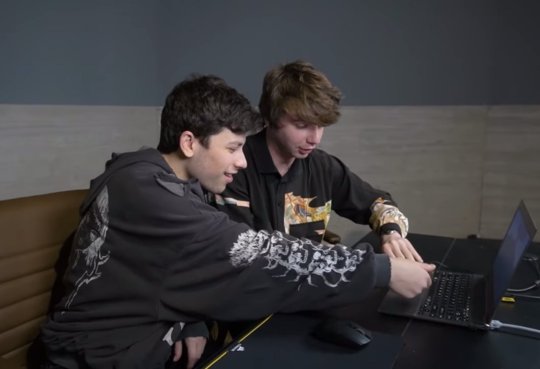
The concept is definitely Mr. Beast inspired but at least it isn't just another Mr. Beast Gaming video lol I've seen so many other YouTubers use the same concept of reviewing the same things but with wildly different price tags in order to pit them against each other. This concept is so popular because I think people just like being able to see the most expensive and fancy stuff cause not many people would have access to say a billion dollar yacht like Mr. Beast does. But, for example, someone reviewing a $1 curling iron versus a $1,000 curling iron would be much more useful to the average viewer cause that is something people might actually be able to afford and be interested in buying but want to know whether any extra money is worth the price. This is one of the first thumbnails that I saw when I searched "$1 v" on YouTube btw (after all the Mr. Beast results lmao) and it already has a million views after just two days.

Update on Karl's thumbnail: He used a new picture of himself so I guess reusing the old one didn't work as planned or he only intended to use it again for that one video.
I wish we could have gotten more footage of when he played Minecraft on the $25,000 movie theater screen cause that one was the most interesting to me but I had a hard time getting a sense of the scale of it with what we got in the final video.
Anyway, I think Karl will stick with mostly Minecraft content on his channel but he'll do some other games like GTA as well.
2 notes
·
View notes
Note
My hypothesis is that a lot of this comes from people just fundamentally not understanding how big these numbers are. It's the same stumbling block that makes a lot of people struggle with, say, "it is inherently unethical to hoard a billion dollars".
Most conventional artists reference existing images - some of them copyrighted, even! This is generally considered to be fine, unless you're copying any one of them SUPER directly. If I reference a pose from one photo, a general composition from some painting, a character design from a few screenshots of my favorite media, etc., etc., no one can say I've stolen that - you can't own a pose, or a general idea of a composition, and we're all in agreement on this website that fanart is fine, yes? And with art, the more references you have, the more you "dilute the pool", in a sense; the more pieces you reference, the less influence you take from any one of them, and the more original the resulting piece. Both legally and culturally, this is generally considered to fall under fair use.
Now realize that referencing manually is taking SEVERAL orders of magnitude more influence from those images than any AI image takes from any given image in its dataset. Yes, even in the unlikely event that your references folder for a single piece is 1,000 images strong! We are talking anywhere from hundreds of millions to actual billions, depending on what you're looking at.
Let's do the rice visualization. If each image was a grain of rice (~0.03 grams), and we consider a model trained on 400 million images, then we are looking at 12,000 kg of rice - which works out to be almost exactly the capacity of a 20-foot shipping container, assuming the rice is in bags neatly loaded on pallets for shipping (it would fill approximately half the container loose). Can you really argue that it's ripping off your single grain? Hell, even if 1,000 grains represent your work, that's just 30 grams. That's about 1/6 of a cup, out of, again, a fully loaded 20-foot shipping container. Even if the popular copy-paste myth were true (and assemblage/collage weren't well established art forms for that matter), it kind of becomes a big bag of "so what?" at that point - the end result is so far abstracted from the art "collected" to make the model that you might as well be arguing that all writing is plagiarism because someone else came up with the words and grammatical structures, or that you own the concept of a cat or a chair or the rule of thirds or the fire and ice color palette; even more so when you realize that this isn't even how it works in the first place and that what's really going on under the hood during the training process is just a lot of really complex (and genuinely fascinating) math to statistically analyze what vague patterns of pixels these images labeled "horse" or "17th century" or "oil on canvas" have in common.
Can you imagine trying to split a penny between each grain of rice in a fully loaded 20-foot shipping container? Hell, even a whole dollar? Can you imagine a way this would work that would actually get artists compensated, WITHOUT kneecapping science? Because all I can imagine is a beautifully wrapped Christmas present for Adobe and Getty Images that passes itself off as a benefit by giving artists 1% of the money such that it amounts to maybe 20 cents a year per person if they're very prolific and lucky, while people trying to do meaningful studies get caught up in expensive red tape.
Anyway here's a knight playing Fortnite

sorry, a bit confused on your AI art take. Are you pro-AI art on the simple basis that humans have to input a prompt first? What of the artists whose work was stolen for that data set? Do they just not matter or have you just not considered them?
i'm not 'pro-AI' -- i don't really care about the technology itself as more than a novelty. i think there's some really talented people doing cool things with it but as a new artform the vast majority of the stuff being made with it fucking sucks. it enables a lot of really shitty business practices (that, mind you, were already standard -- it just makes them easier). much like any advancent in productive technology its implementation under capitalism will inevitably be immiserating. i just think that 1. generative art is indisputably art and almost every argument i've seen that it isn't is openly reactionary and 2. many of the arguments against it are equally reactionary petty-bourgeois nonense that drown out the actual labour concerns of how employers' use of it affects the proletariat.
that said i simply don't believe that anyone's work is being 'stolen' when datasets are created and AI is trained on them. they're not being deprived of anything! i definitionally think something cannot be a 'theft' if nothing is lost or taken, and i furthermore think that the ability to freely scrape words and images off the internet is actually incredibly vital to a lot of very important research and the idea that it represents 'theft' when those words and images are not even being reproduced is absolute nonsense.
like when people say that images have been used "without compensation", what do they imagine "compensation" looks like? like, the CLIP dataet that DALL-E 2 was trained on has 400 million images in it. DALL-E 2 charges (after a free trial period) $0.02 per image. so should each of the owners (not creators, mind you, because IP law does not protect creators and in fact demonstrably does the opposite) of the images in CLIP then get $0.000000005 whenever DALL-E 2 generates an image? be serious! barbie playset of the bulgarian presidential palace
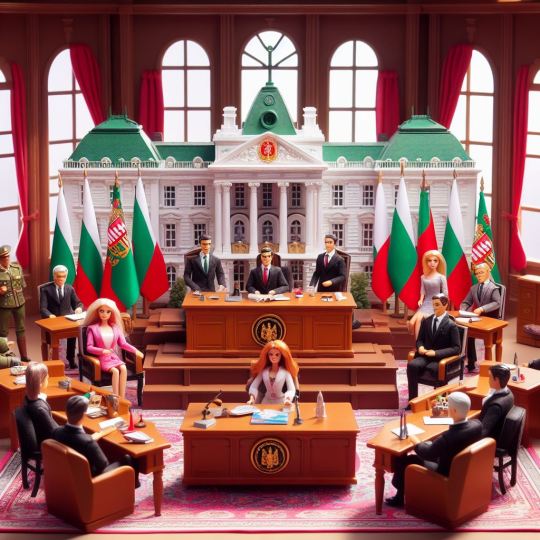
1K notes
·
View notes